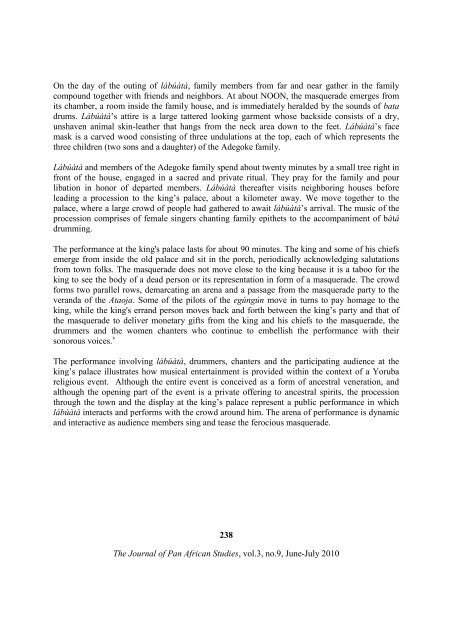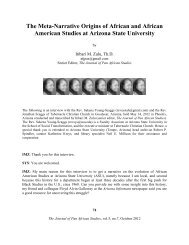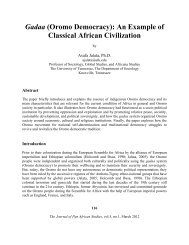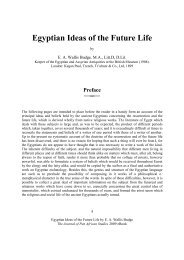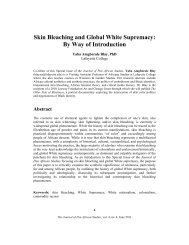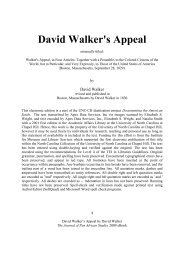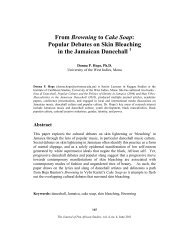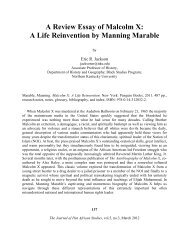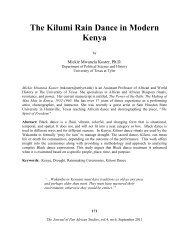Rhythms of the Gods: Music, Spirituality and Social Engagement in ...
Rhythms of the Gods: Music, Spirituality and Social Engagement in ...
Rhythms of the Gods: Music, Spirituality and Social Engagement in ...
You also want an ePaper? Increase the reach of your titles
YUMPU automatically turns print PDFs into web optimized ePapers that Google loves.
On <strong>the</strong> day <strong>of</strong> <strong>the</strong> out<strong>in</strong>g <strong>of</strong> lábúàtà, family members from far <strong>and</strong> near ga<strong>the</strong>r <strong>in</strong> <strong>the</strong> family<br />
compound toge<strong>the</strong>r with friends <strong>and</strong> neighbors. At about NOON, <strong>the</strong> masquerade emerges from<br />
its chamber, a room <strong>in</strong>side <strong>the</strong> family house, <strong>and</strong> is immediately heralded by <strong>the</strong> sounds <strong>of</strong> bata<br />
drums. Lábúàtà’s attire is a large tattered look<strong>in</strong>g garment whose backside consists <strong>of</strong> a dry,<br />
unshaven animal sk<strong>in</strong>-lea<strong>the</strong>r that hangs from <strong>the</strong> neck area down to <strong>the</strong> feet. Lábúàtà’s face<br />
mask is a carved wood consist<strong>in</strong>g <strong>of</strong> three undulations at <strong>the</strong> top, each <strong>of</strong> which represents <strong>the</strong><br />
three children (two sons <strong>and</strong> a daughter) <strong>of</strong> <strong>the</strong> Adegoke family.<br />
Lábúàtà <strong>and</strong> members <strong>of</strong> <strong>the</strong> Adegoke family spend about twenty m<strong>in</strong>utes by a small tree right <strong>in</strong><br />
front <strong>of</strong> <strong>the</strong> house, engaged <strong>in</strong> a sacred <strong>and</strong> private ritual. They pray for <strong>the</strong> family <strong>and</strong> pour<br />
libation <strong>in</strong> honor <strong>of</strong> departed members. Lábúàtà <strong>the</strong>reafter visits neighbor<strong>in</strong>g houses before<br />
lead<strong>in</strong>g a procession to <strong>the</strong> k<strong>in</strong>g’s palace, about a kilometer away. We move toge<strong>the</strong>r to <strong>the</strong><br />
palace, where a large crowd <strong>of</strong> people had ga<strong>the</strong>red to await lábúàtà’s arrival. The music <strong>of</strong> <strong>the</strong><br />
procession comprises <strong>of</strong> female s<strong>in</strong>gers chant<strong>in</strong>g family epi<strong>the</strong>ts to <strong>the</strong> accompaniment <strong>of</strong> bàtá<br />
drumm<strong>in</strong>g.<br />
The performance at <strong>the</strong> k<strong>in</strong>g's palace lasts for about 90 m<strong>in</strong>utes. The k<strong>in</strong>g <strong>and</strong> some <strong>of</strong> his chiefs<br />
emerge from <strong>in</strong>side <strong>the</strong> old palace <strong>and</strong> sit <strong>in</strong> <strong>the</strong> porch, periodically acknowledg<strong>in</strong>g salutations<br />
from town folks. The masquerade does not move close to <strong>the</strong> k<strong>in</strong>g because it is a taboo for <strong>the</strong><br />
k<strong>in</strong>g to see <strong>the</strong> body <strong>of</strong> a dead person or its representation <strong>in</strong> form <strong>of</strong> a masquerade. The crowd<br />
forms two parallel rows, demarcat<strong>in</strong>g an arena <strong>and</strong> a passage from <strong>the</strong> masquerade party to <strong>the</strong><br />
ver<strong>and</strong>a <strong>of</strong> <strong>the</strong> Ataoja. Some <strong>of</strong> <strong>the</strong> pilots <strong>of</strong> <strong>the</strong> egúngún move <strong>in</strong> turns to pay homage to <strong>the</strong><br />
k<strong>in</strong>g, while <strong>the</strong> k<strong>in</strong>g's err<strong>and</strong> person moves back <strong>and</strong> forth between <strong>the</strong> k<strong>in</strong>g’s party <strong>and</strong> that <strong>of</strong><br />
<strong>the</strong> masquerade to deliver monetary gifts from <strong>the</strong> k<strong>in</strong>g <strong>and</strong> his chiefs to <strong>the</strong> masquerade, <strong>the</strong><br />
drummers <strong>and</strong> <strong>the</strong> women chanters who cont<strong>in</strong>ue to embellish <strong>the</strong> performance with <strong>the</strong>ir<br />
sonorous voices. v<br />
The performance <strong>in</strong>volv<strong>in</strong>g lábúàtà, drummers, chanters <strong>and</strong> <strong>the</strong> participat<strong>in</strong>g audience at <strong>the</strong><br />
k<strong>in</strong>g’s palace illustrates how musical enterta<strong>in</strong>ment is provided with<strong>in</strong> <strong>the</strong> context <strong>of</strong> a Yoruba<br />
religious event. Although <strong>the</strong> entire event is conceived as a form <strong>of</strong> ancestral veneration, <strong>and</strong><br />
although <strong>the</strong> open<strong>in</strong>g part <strong>of</strong> <strong>the</strong> event is a private <strong>of</strong>fer<strong>in</strong>g to ancestral spirits, <strong>the</strong> procession<br />
through <strong>the</strong> town <strong>and</strong> <strong>the</strong> display at <strong>the</strong> k<strong>in</strong>g’s palace represent a public performance <strong>in</strong> which<br />
lábúàtà <strong>in</strong>teracts <strong>and</strong> performs with <strong>the</strong> crowd around him. The arena <strong>of</strong> performance is dynamic<br />
<strong>and</strong> <strong>in</strong>teractive as audience members s<strong>in</strong>g <strong>and</strong> tease <strong>the</strong> ferocious masquerade.<br />
238<br />
The Journal <strong>of</strong> Pan African Studies, vol.3, no.9, June-July 2010


